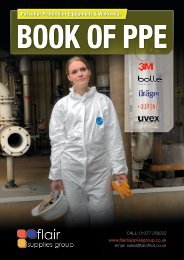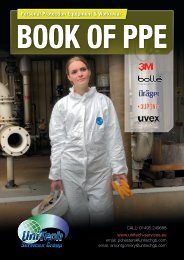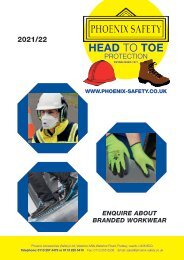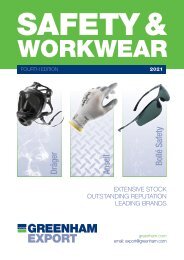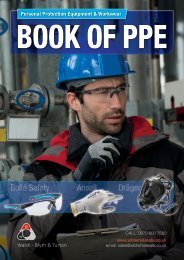Phoenix PPE Catalogue
Phoenix PPE Catalogue
Phoenix PPE Catalogue
Create successful ePaper yourself
Turn your PDF publications into a flip-book with our unique Google optimized e-Paper software.
Hand Protection<br />
Buying Guide<br />
Choose the right hand protection<br />
European Standards<br />
Implies that the gloves comply with the basic requirements laid down by the EEC<br />
directive: Personal Protective Equipment.<br />
Simple Design (Category 1)<br />
For areas of ‘minimal risk’ where the effects of not wearing a glove are easily<br />
reversible or superficial. Such products are self-certified.<br />
Intermediate Design (Category 2)<br />
For areas of specific risk i.e. mechanical risks. Such products will have been EC<br />
type tested against European test methods and certified by a notified body.<br />
Complex Design (Category 3)<br />
For areas/applications that can seriously or irreversibly harm the health. Such<br />
products, in addition to the CE type test, will also have to be either produced<br />
under an approved quality system OR be type tested on an annual basis.<br />
Health & Safety<br />
Hands at work are extremely vulnerable to a wide range of hazards<br />
which include cuts, blows, chemical attack and temperature<br />
extremes. With industry’s increasingly complex and sensitive<br />
manufacturing and handling processes, there is a growing<br />
insistence on the use of “job fitted” gloves that meet each user’s<br />
specific requirements; hence our offering of a wider and more<br />
comprehensive range of gloves in this section – in excess of 200<br />
different types and styles from which to choose.<br />
Maintenance<br />
Contaminated and worn gloves may fail to protect the hands<br />
from the very hazard they were designed for. Effective protection<br />
is maintained by regular replacement of the gloves. Check the<br />
condition of the gloves, inside and out.<br />
EUROPEAN STANDARDS<br />
EN 374-2 Chemical & Micro-organisms<br />
Low Chemical resistant or Waterproof glove pictogram is to be used for those gloves that do not achieve a breakthrough time of at<br />
least 30 minutes against at least three chemicals from the pre-defined list (but which comply with the Penetration test).<br />
EN 374-3 Chemical & Micro-Organisms<br />
This standard specifies the capability of gloves to protect the user against chemicals and/or micro-organisms.<br />
Resistance to penetration by micro-organisms. Referred to as acceptable quality level (AQL).<br />
EN 388 Mechanical Hazards<br />
This standard applies to all kinds of protective gloves giving protection from mechanical risks, in respect of physical problems caused<br />
by abrasion, blade cut, puncture or tearing. This standard also covers risk of electrostatic discharge.<br />
A) Resistance to abrasion – Rating 0-4<br />
B) Blade cut resistance – Rating 0-5<br />
C) Tear resistance – Rating 0-4<br />
D) Puncture resistance – Rating 0-4<br />
EN 407 Thermal Hazards<br />
This standard specifies thermal performance for protective gloves against heat and/or fire.<br />
A) Burning behaviour – Rating 0-4<br />
B) Contact heat – Rating 0-4<br />
C) Convective heat – Rating 0-4<br />
D) Radiant heat – Rating 0-4<br />
E) Small splashes of molten metal – Rating 0-4<br />
F) Large splashes of molten metal – Rating 0-4<br />
EN 659 Thermal Hazards<br />
This standard defines performance requirements for gloves designed to protect fire fighters against heat and flames.<br />
EN 511 Protection from cold<br />
This standard applies to gloves which protect the hands against convective and contact cold.<br />
A) Resistance to convective cold – Rating 0-4<br />
B) Resistance to contact cold – Rating 0-4<br />
C) Permeability to water – Rating 0-1<br />
Food Handling<br />
Gloves suitable for food handling must carry this symbol or be labelled ‘For Food Use’.<br />
CE Mark<br />
CE implies that the gloves comply with the basic requirements laid down by the EEC directive: Personal Protective Equipment.<br />
EN 421 Radioactive Hazards<br />
This standard lays down test methods and performance criteria for gloves offering protection against ionising radiation and radioactive<br />
contamination.<br />
36




